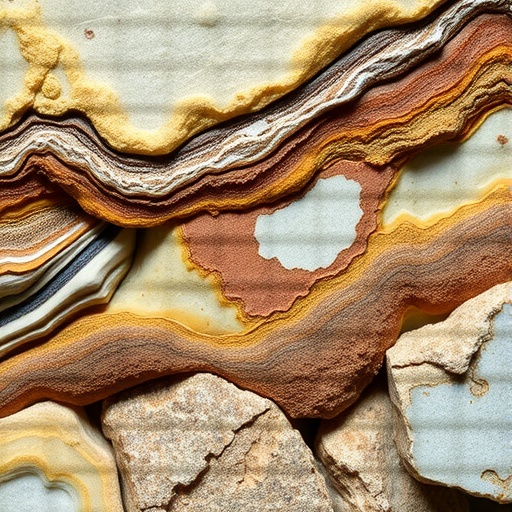In recent years, the exploration and classification of organic-rich shales have gained significant importance in the field of geology and natural resource management. Shale formations, known for their rich organic content, serve as major sources for hydrocarbons, especially in times when conventional fossil fuel resources are dwindling. In an enlightening study published in 2025, Jiang et al. introduced a comprehensive lithofacies classification scheme aimed at refining our understanding of these complex geological formations. This pioneering scheme not only classifies different lithofacies but also correlates them with their respective organic content, enabling geologists and industry stakeholders to better assess potential resource locations.
The organic-rich shale lithofacies classification scheme is an elaborate system that categorizes shale based on intrinsic characteristics such as mineral composition, grain size, and especially organic matter content. The classification system proposed by Jiang and colleagues emphasizes the importance of organofacies—distinctive units within shales that reflect varying stages of organic maturation. By applying advanced analytical techniques, the researchers were able to redefine previously established boundaries between lithofacies, enhancing the predictive capabilities of resource potential assessments.
One crucial aspect of the research lies in the methodological framework employed by the authors. Utilizing a multi-disciplinary approach, the study integrates sedimentology, geochemistry, and petrophysics to provide a holistic understanding of the shale formations. This comprehensive methodology allows for more accurate predictions regarding hydrocarbon yields and resource distribution. By systematically analyzing core samples and well-log data, the researchers established a strong correlation between lithofacies types and their expected organic-richness levels.
Additionally, this classification scheme holds significant implications for the oil and gas industry. With the advent of hydraulic fracturing and horizontal drilling, understanding the subtleties of shale formations is paramount for efficient resource extraction. By employing Jiang et al.’s classification, operators can optimize their drilling strategies and enhance recovery efficiencies. The ability to predict production potential based on lithofacies classification can lead to reduced operational costs and decreased environmental impact associated with shale development.
The applicability of the classification scheme extends beyond oil and gas exploration. Given that organic-rich shales also serve as valuable sources of critical minerals and rare earth elements, this newly developed lithofacies classification could aid in the exploration of these resources. As the world shifts towards renewable technologies, the demand for such minerals is only set to increase; thus, understanding the distribution of these elements within organic-rich shales becomes imperative.
In their discussion, Jiang et al. also articulate the challenges posed by the inherent heterogeneity found in shale deposits. Variability in organic content, porosity, and permeability can lead to inconsistent production rates, making accurate classification essential for successful resource management. The authors advocate for continuous refinement of lithofacies classification systems as new data becomes available, emphasizing the dynamic nature of geological research.
Moreover, the implications of their findings resonate well with the ongoing debates concerning climate change and sustainable development. As we witness an increasing global push for carbon neutrality, there is a pressing need for effective resource utilization strategies. A deeper understanding of organic-rich shales, guided by Jiang et al.’s classification scheme, can assist in discerning when and where it is appropriate to harness these resources while balancing environmental concerns.
The results of this study demonstrate that interdisciplinary approaches not only enrich our understanding of complex geological formations but also enhance practical outcomes in resource extraction. As the quality and quantity of data continue to expand, real-time assessments of shale formations will become more attainable, leading to more informed decision-making in both industry and policy-making contexts. The promise of optimizing hydrocarbon recovery while minimizing environmental footprints exemplifies the potential realizable when thorough geological research integrates cutting-edge classification schemes.
Furthermore, the study’s findings will likely spark a wave of subsequent research aiming to further dissect and analyze organic-rich shale formations worldwide. The implications of an improved classification scheme could extend into various regions, potentially uncovering previously overlooked reservoirs and contributing to energy independence for nations rich in shale resources. Jiang et al.’s work sets a solid foundation for future geological explorations, cultivating an environment of collaboration among researchers, industry experts, and policymakers.
As we progress further into the 21st century, the importance of enhancing our understanding of organic-rich shales cannot be overstated. The pursuit of innovative classification methods, as demonstrated by Jiang and colleagues, demonstrates a thoughtful approach to addressing one of the most pressing challenges of our time: balancing resource demand with sustainable practices. Their contributions will undoubtedly inspire further research aimed at optimizing our understanding of the Earth’s geological resources and ensuring that we can responsibly harvest energy solutions in the years to come.
In summary, Jiang et al.’s innovative classification scheme represents a significant step forward in the understanding and management of organic-rich shales. As interdisciplinary methodologies become increasingly commonplace in geological research, the potential for realizing improved resource assessments and recovery strategies grows exponentially. By fostering collaboration and continuously refining classification systems, we can look forward to a future where we harness natural resources more efficiently and responsibly, all while protecting our environment for the generations that follow.
Subject of Research: Shale lithofacies classification and organic content analysis
Article Title: Organic-Rich Shale Lithofacies Classification Scheme: Application and Discussion
Article References:
Jiang, X., Zhou, N., Li, B. et al. Organic-Rich Shale Lithofacies Classification Scheme: Application and Discussion.
Nat Resour Res (2025). https://doi.org/10.1007/s11053-025-10545-3
Image Credits: AI Generated
DOI: 10.1007/s11053-025-10545-3
Keywords: organic-rich shales, lithofacies classification, hydrocarbons, geological formations, energy resources, resource management




